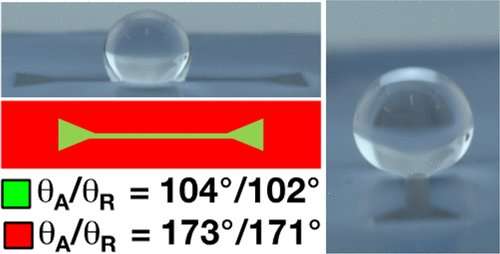Creating surfaces that repel water and control its flow

To prevent water and ice from making our shoes soggy, frosting our car windows and weighing down power lines with icicles, scientists have been exploring new coatings that can repel water. Now one team has developed a way to direct where the water goes when it's pushed away. Their report appears in the journal ACS Applied Materials & Interfaces.
Water-repelling, or superhyrdophobic, materials are already commercially available. But when blown by wind or subjected to a slight tilt, the water droplets on these surfaces will glide away in a direction determined by the initial nudge. To gain better control over the flow of water on superhydrophobic materials, scientists have been etching paths into coatings for the liquid to follow. And although water will take the designated path, it can leave behind a wet trail. Previous studies suggest that on these paths, rolling droplets have a different contact angle at the front and back— they're rounded in front but flatter in the back—and this causes the wet residue. Thomas McCarthy and colleagues wanted to address this shortcoming by aiming for more rounded droplets.
The researchers started with superhydrophobic silicon wafers, in which they cut straight, circular and wavy tracks using photolithography. Then they exposed the material to an oxygen plasma cleaner and treated it with a vapor of silicone nanofilaments to make the tracks hydrophobic. This novel step was critical for keeping water droplets' spherical shape and minimizing the difference in the front and back contact angles. Testing showed that water flowed along the designated paths without leaving a trace.
More information: Ting Dong et al. Superhydrophobic, Low-Hysteresis Patterning Chemistry for Water-Drop Manipulation, ACS Applied Materials & Interfaces (2017). DOI: 10.1021/acsami.7b15739
Abstract
A method for preparing superhydrophobic surfaces containing guiding lines that control water motion is described. The background surfaces exhibit contact angles of θA/θR = 173°/171°, and the guiding lines are also hydrophobic (θA/θR = 104°/102°). The low-contact-angle hysteresis allows facile water motion. The sequence of steps used to prepare these surfaces is central to their success, is designed to minimize defects, and involves only two inexpensive and fluorine-free reagents: methyltrichlorosilane and dimethyldichlorosilane. Examples of patterned surfaces that direct water motion are described. The disparity in receding contact angles is identified as the key parameter for guided motion.
Journal information: ACS Applied Materials and Interfaces
Provided by American Chemical Society




















